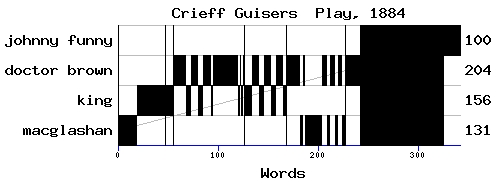Context:
| Location: |
Crieff, Perthshire, Scotland (NN8621) |
| Year: |
Perf. about 1884 |
| Time of Occurrence: |
[Not given] |
| Collective Name: |
Disguisers, Guisers |
|
Source:
M.J.P.Lawrence
Guisers' Play
Scots Magazine, NS 66,
Dec.1956, No.3, pp.197-201
|
Cast:
|
Text:
{But now the ring is formed and the play begins. Jack
Macglashan swaggers forward and pronounces in a round voice:}
MACGLASHAN
Macglashan, Macglashan, Macglashan is my name,
My sword and buckler by my side, I hope to win the game.
THE KING
The game, sir, the game, sir, is not within your power,
I'll draw my bloody dagger and slay you to the floor.
{A brisk fight ensues, and Jack falls wounded.}
Then call for Doctor Brown,
the best old greasy doctor in the town.
{Out springs Doctor Brown with suitable medical props.}
DOCTOR
Here am I, Doctor Brown,
The best old greasy doctor in the town.
KING
How far have you travelled?
DOCTOR
Oh, round the world and back again.
KING
What did you see there?
DOCTOR
Mountains of porridge and rivers of butter milk.
KING
Anything else?
DOCTOR
Yes, cocks and hens with knives and forks in their backs,
running down the streets calling out,
'who'll eat me? Who'll eat me?'
KING
Anything more?
DOCTOR
No.
KING
Anything less?
DOCTOR
No.
KING
What'll you take to cure a man?
DOCTOR
Ten pounds and a bottle of wine.
KING
I'll give you three.
DOCTOR
Ten pounds and a bottle of wine.
KING
I'll give you three.
DOCTOR
Ten pounds and a bottle of wine.
KING
Cure him then.
DOCTOR
Two drops to your nose and one to your toes.
Rise, Jack, and sing.
MACGLASHAN
I can't.
DOCTOR
Why not?
MACGLASHAN
I've got a hole in my side that would let a coach and four through it.
DOCTOR
How did you get that?
MACGLASHAN
Fighting the French.
DOCTOR
How many did you kill?
MACGLASHAN
All but one.
DOCTOR
What happened to him?
MACGLASHAN
He ran away.
{The Doctor once more stoops over Jack with a slightly stronger potion.}
DOCTOR
Three drops to your nose and two to your toes.
Rise up. Jack, and sing.
JACK (AND ALL)
Once I was dead and now I'm alive,
Blessed be the doctor that made me alive.
We'll all join hands and we'll never fight no more,
And we'll be as brothers as we were before.
Bless the master of this house and bless the mistress, too,
And all the little children around the table too.
With their pockets full of money and their bottles full of beer,
We wish you all a merry Christmas and a happy New Year.
{Clapping and congratulations.}
JOHNNY FUNNY
Here am I, wee Johnny Funny,
Wi' my tunny,
I'm the man that takes the money.
|
Notes:
Lawrences Notes:
"An old man's memory - the Guisers' play of Macglashan as performed in Crieff, Perthshire, about 1884 ... the last night of the year that saw the performances of the Disguisers or Guisers. There were several large families in Crieff in the eighties. Some time before the end of the year, a group of boys get together from one or two families of playmates, and prepare the well-known Guisers' play. The leader would take the part of Macglashan. That is the Galgacus character, according to E.K. Chambers, although it has been suggested that he is Mac, that is to say the son of, the Galatian, Saint George himself.
. . . other parts of the King, the Doctor and Johnny Funny . . . There were also a few supernumaries. The play was rehearsed . . . disguisings, crude ones, were chosen ... a grown-up jacket, turned out, and old grown-up hats squashed or folded upon the head.
. . . performances were mostly to grown-ups at home, or to friends of the family, as anything like begging was frowned upon by his mother.
. . . The boys would be invited into the kitchen. Mother would certainly remain as audience and any any grown-ups who could be bothered with the plays of children. The age of the players was much younger than the (Thomas) Hardy band . . ."
Indexers Notes:
Scanned from the transcript in:
B.Hayward (1992) Galoshins : The Scottish Folk Play. Edinburgh, Edinburgh University Press, 1992, ISBN 07486 0338 7, pp.134-138.
Haywards Notes:
"The custom in Crieff may not be ancient. The town was completely destroyed in 1716, and repaired in 1731. The town became an industrial centre for a while in the late eighteenth and early nineteenth centuries, and a spa later in the nineteenth century. The interruption in the town's history, and the cause for immigration in the ninteenth century, may well mean that the play in this location is a relatively recent transplant."
|
File History:
2002-02-22 - Scanned and Coded by Peter Millington
2021-01-15 - TEI-encoded by Peter Millington
|
Extras:
Dramaturgical Chart

The chart reveals the dramaturgical structure of the play by showing which speeches in the script are spoken by which character. Vertical lines indicate stage directions.
TEI-encoded File
A TEI-encoded XML version of this text can be downloaded here.
Text Relatives Map
See how many of the lines in this text also appear in other plays:
- As a histogram sorted by the number of shared lines
- On a map with markers sized according to the number of shared lines
Other Information
There may be more about this text at:
https://folkplay.info/resources/texts-and-contexts/crieff-guisers-play-1884.
|
|